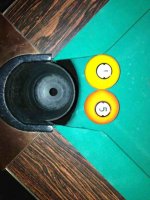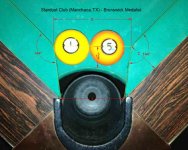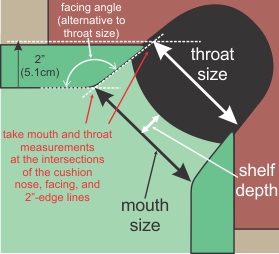Below is the latest updated list after the recent changes to the
PSF and
PAF. Things didn't change very much overall, but the tables that people claimed were rated too low or high before, based on pocket size alone, now have more-appropriate ratings.
Please let me know what your think about the recent changes and new ratings.
Regards,
Dave
Measurements and data reported by AZB users for
table difficulty factor (TDF), based on the
table size factor (TSF),
pocket size factor (PSF),
pocket angle factor (PAF), and
pocket shelf factor (PLF):
name -- table_size:TSF -- pocket_mouth_size SF -- mouth-throat_difference
SF -- mouth-throat_difference AF -- shelf_depth
AF -- shelf_depth LF -- TDF (table description)
LF -- TDF (table description)
dr_dave -- 10':1.10 -- 4":1.20 -- 3/4":1.02 -- 1 7/8":1.03 --
1.39 (fictitious tough 10' table example)
dr_dave -- 9':1.00 -- 3 7/8":1.25 -- 5/8":1.00 -- 2 1/8":1.07 --
1.34 (fictitious example "B")
Bonus Ball -- 9':1.00 -- 3 7/8":1.25 -- 1/8":0.97 -- 3/4":0.98 --
1.19 (Bonus Ball table)
Bob Dixon -- 9':1.00 -- 4":1.20 -- 1/2":0.99 -- 1 3/8":0.99 --
1.18 (Pool Sharks, Las Vegas, money table, Diamond Pro-Am, red logo, Ernesto Dominguez-modified)
MahnaMahna -- 10':1.10 -- 5 1/2":0.85 -- 2":1.09 -- 2 1/2": 1.15 --
1.17 (snooker table poorly converted into a pool table)
Qaddiction -- 9':1.00 -- 4 1/8":1.15 -- 3/4":1.02 -- 1 3/8":0.99 --
1.16 (Diamond)
rexus31 -- 9':1.00 -- 4":1.20 -- 3/8":0.98 -- 1":0.98 --
1.15 (mid to late 50's AMF Commercial Model similar to a Brunswick Anniversary/Sport King)
FatBoy -- 9':1.00 -- 4":1.20 -- 1/4":0.97 -- 1":0.98 --
1.14 (Ernesto-Dominguez-modified Brunswick Gold Crown)
TATE -- 9':1.00 -- 4":1.20 -- 1/4":0.97 -- 7/8":0.98 --
1.14 (Ernesto-Dominguez-modified Brunswick Gibson)
Neil -- 7':0.85 -- 4 1/8":1.15 -- 1 1/4":1.14 -- 1 3/8":0.99 --
1.10 (modified Valley "bar box")
cigardave -- 9':1.00 -- 4 1/2":1.00 -- 1":1.07 -- 1 3/4":1.00 --
1.07 (typical Pro-Cut Diamond)
Pool Hustler -- 9':1.00 -- 4 1/4":1.10 -- 1/4":0.97 -- 15/16":0.98 --
1.05 (modified Brunswick Gold Crown, measured by rexus31)
JC -- 9':1.00 -- 4 7/16":1.00 -- 143 deg:1.07 -- 1 3/8":0.98 --
1.05 ("Cobrasized" Brunswick Gold Crown III)
SloMoHolic -- 9':1.00 -- 4 1/2":1.00 -- 7/8":1.04 -- 1 3/8":0.98 --
1.02 (2005 Diamond Pro with ProCut pockets and Red-label rails)
oldschool1478 -- 9':1.00 -- 4 1/2":1.00 -- 141 deg:1.02 -- 1 3/4:1.00 --
1.02 (updated Red Badge Diamond Pro)
"standard" table -- 9':1.00 -- 4 7/16":1.00 -- 9/16":1.00 -- 1 5/8":1.00 --
1.00 (WPA spec "standard")
Kelly_Guy -- 9':1.00 -- 4 1/2":1.00 -- 1/2":0.98 -- 1 5/8":1.00 --
0.98 (Antique Brunswick Jefferson, circa 1900)
dr_dave -- 9':1.00 -- 5": 0.91 -- 1 1/8":1.10 -- 1 3/8":0.98 --
0.98 (old Brunswick Gold Crown II at MatchUps, Fort Collins)
BryanB -- 9':1.00 -- 4 1/2":1.00 -- 3/4":1.02 -- 1 1/4":0.95 --
0.97 (1931 Brunswick with double shimmed pockets)
dzcues -- 9':1.00 -- 4 7/8":0.91 -- 11/16":1.02 -- 1 15/16":1.03 --
0.96 (typical League-Cut Diamond)
dzcues -- 9':1.00 -- 5":0.91 -- 15/16":1.07 -- 1 1/2":0.98 --
0.95 (Gandy Big G)
Sloppy Pockets -- 8'+:0.95 -- 5":0.91 -- 1 1/8":1.10 -- 1 3/4":1.00 --
0.95 (A.E. Schmidt)
44Runner -- 8'+/-:0.925 -- 4 3/8":1.05 -- 3/4":1.02 -- 1":0.95 --
0.94 (8' Diamond Pro-Am - blue label)
mamics -- 9':1.00 -- 4 11/16":0.95 -- 7/8":1.04 -- 1 3/16":0.95 --
0.94 (no-name "Chinese Cheapie" with Uylin cushions)
12squared -- 9':1.00 -- 4 7/8":0.91 -- 3/4":1.02 -- 1 1/2":0.98 --
0.91 (Brunswick Gold Crown home table)
iusedtoberich -- 9':1.00 -- 5 1/8":0.88 -- 1":1.05 -- 1 1/2":0.97 --
0.90 ("loose" Brunswick Gold Crown)
MSchaffer -- 9':1.00 -- 5 1/8":0.88 -- 3/4":1.01 -- 1 3/4":1.00 --
0.89 (Brunswick Gold Crown II)
mfinkelstein3 -- 9':1.00 -- 5 1/8":0.88 -- 7/8":1.03 -- 1 1/2": 0.97 --
0.88 ("loose" Brunswick Gold Crown III)
Vahmurka -- 9':1.00 -- 5 1/8":0.88 -- 7/8":1.03 -- 1 1/2": 0.97 --
0.88 (Brunswick Centurion)
Dopc -- 8':0.90 -- 4 1/2":1.00 -- 3/4":1.02 -- 1 1/4":0.95 --
0.87 (8' Connelly Kayenta)
SloMoHolic -- 8':0.90 -- 4 3/4":0.95 -- 3/4":1.02 -- 1 5/8":1.00 --
0.87 (old 8' Brunswick Medalist league table)
SloMoHolic -- 8'+:0.95 -- 4 7/8":0.91 -- 7/8":1.04 -- 1 1/4":0.95 --
0.85 (Brunswick Medalist at Stardust Club in Manchaca, TX)
dr_dave -- 8':0.90 -- 4 3/4":0.95 -- 5/8":1.00 -- 1 3/8":0.98 --
0.84 (8' Connelly home table)
BRussell -- 8':0.90 -- 5":0.91 -- 13/16":1.04 -- 1 1/2":0.98 --
0.83 (8' Olhausen)
dr_dave -- 8':0.90 -- 5":0.91 -- 1/2":0.98 -- 1 3/8":0.98 --
0.79 (fictitious 8' example "A")
Mooneye -- 7':0.85 -- 4 7/8":0.91 -- 3/4":1.02 -- 1 5/8":1.00 --
0.79 (7' Brunswick "Ranchero")
SloMoHolic -- 6':0.85 -- 4 1/2":1.00 -- 0":0.95 -- 5/8":0.95 --
0.77 (old 6' Valley "bar box")
dzcues -- 7':0.85 -- 4 1/2":1.00 -- 0":0.95 -- 1/2":0.95 --
0.77 (7' Valley "bar box")
dr_dave -- 7':0.85 -- 4 1/2":1.00 -- 0":0.95 -- 3/4":0.95 --
0.77 (7' Valley/Dynamo "bar box" at West End, Fort Collins)









